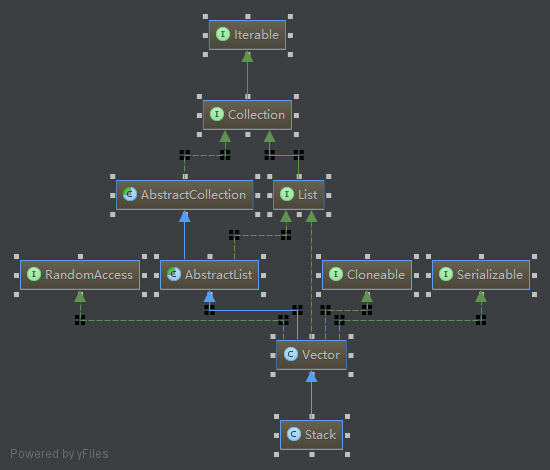一、简介

stack类图.png
栈是数据结构中一种很重要的数据结构类型,因为栈的后进先出功能是实际的开发中有很多的应用场景。Java API中提供了栈(Stacck)的实现。Stack类继承了Vector类,而Vector类继承了AbstractList抽象类,实现了List类,Cloneable接口,RandomAcces接口以及Serializable接口。
二、源码阅读
1.构造方法public Stack() {
}
创建一个空栈。
2.入栈pushpublic E push(E item) {
addElement(item);
return item;
}
public synchronized void addElement(E obj) {
modCount++;
ensureCapacityHelper(elementCount + 1);
elementData[elementCount++] = obj;
}
入栈是一个同步的方法,调用Vector的addElement方法,也是一个同步方法,先将修改次数加一,之后调用ensureCapacityHelper确认数组有足够的空间能够容纳新的元素。最后将元素新增到数组,即Vector的末尾。
3.出栈poppublic synchronized E pop() {
E obj;
int len = size();
obj = peek();
removeElementAt(len - 1);
return obj;
}
出栈同样是一个同步方法,先定义一个泛型对象obj,获取到数组长度len,然后调用peek()方法,获取栈顶的元素赋值给obj,然后删除栈顶元素。public synchronized E peek() {
int len = size();
if (len == 0)
throw new EmptyStackException();
return elementAt(len - 1);
}
很显然,peek()方法直接调用了Vector的elementAt方法,该方法不删除栈顶的元素。
4.判断栈是否为空/**
* 通过数组长度判断栈是否为空。
*
* @return true if and only if this stack contains
* no items; false otherwise.
*/public boolean empty() {
return size() == 0;
}
5.查询元素到栈顶的距离/**
* Returns the 1-based position where an object is on this stack.
* If the object o occurs as an item in this stack, this
* method returns the distance from the top of the stack of the
* occurrence nearest the top of the stack; the topmost item on the
* stack is considered to be at distance 1. The equals * method is used to compare o to the
* items in this stack.
*
* @param o the desired object.
* @return the 1-based position from the top of the stack where
* the object is located; the return value -1 * indicates that the object is not on the stack.
*/public synchronized int search(Object o) {
int i = lastIndexOf(o);
if (i >= 0) {
return size() - i;
}
return -1;
}
一个同步方法,找到指定元素o到栈顶的距离,可以看到用到了lastIndexOf方法,如果找不到元素,则返回-1。
三、总计
通过源码我们可以看到Vector底层是一个数组,说明Stack的实现是通过数组来实现的,然后通过对数组的操作来模仿栈的各种功能。而且在源码中Vector的很多方法都是synchronized 的,也就是说是线程安全,所以说在多线程中是可以安全使用的,不过这样效率上肯定是会降低的。
本文由职坐标整理并发布,希望对同学们有所帮助。了解更多详情请关注职坐标编程语言JAVA频道
的使用)


)




...)





浅介 (转载))
)



